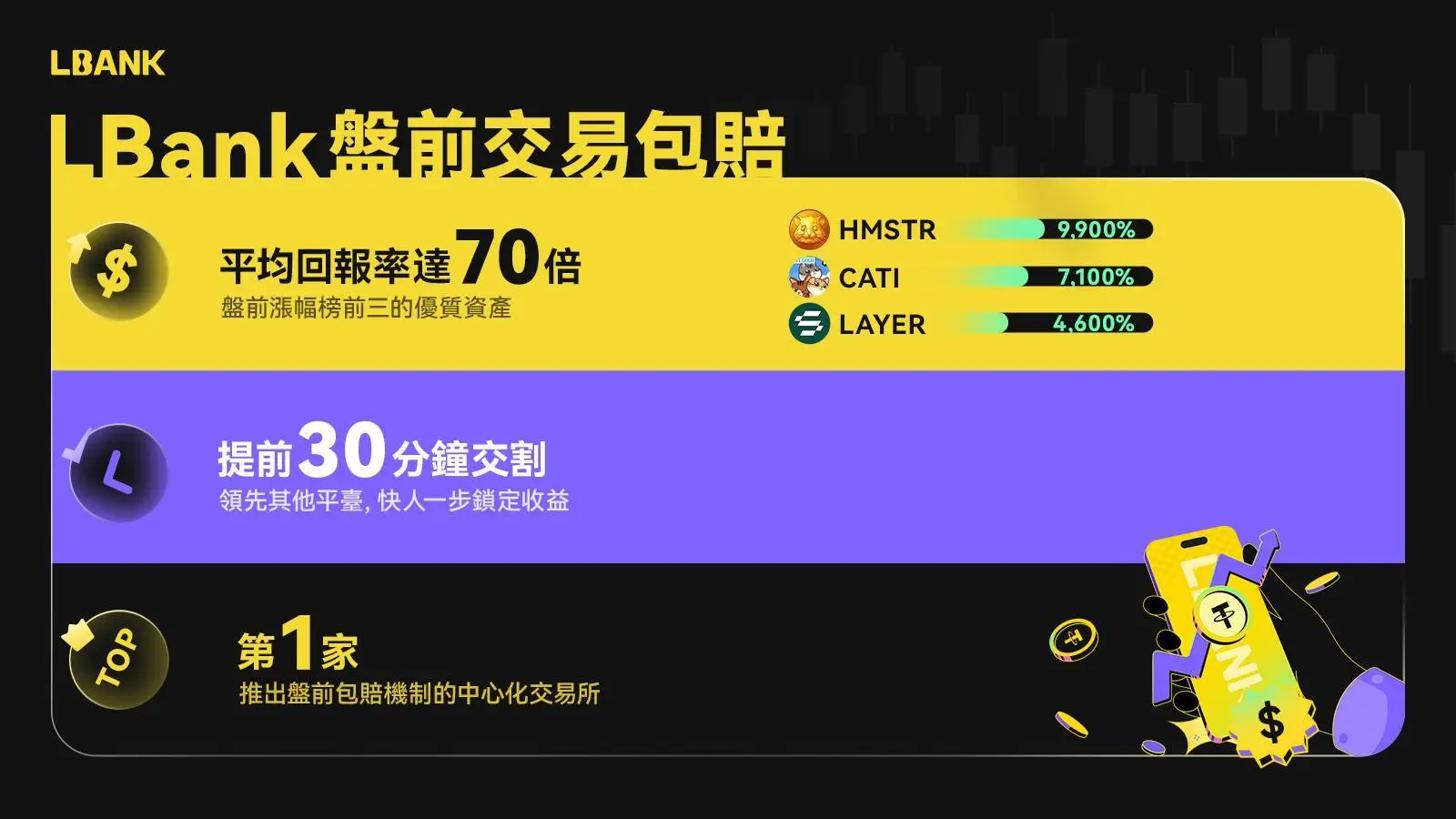How to profit from the first wave of market movement before the market opens: CEX pre-market strategies and profit guide

The crypto market is never short of opportunities, but the first wave of gains always belongs to only a select few. In cryptocurrency trading, the pre-market phase has become a crucial window for competition among the new generation of traders. To some extent, the market has already initiated trends and price movements before the official opening. For individual traders, pre-market strategies often determine two major things: first, whether they can anticipate the starting point of the market narrative; and second, whether they can position themselves before the mainstream sentiment floods in. Ignoring pre-market strategies means missing the golden window from seed valuation to explosive growth.
Those who truly make money pre-market only look at three things:
- When you enter the market, how long has the project been around? The closer it is to the seed round, the more primitive the valuation, and the greater the potential profit.
- At the moment the market opens, will it be possible to sell smoothly? A shallow pre-market session equals a false breakout, and slippage will eat up profits.
- Will someone cover the losses? Trial and error without a buffer = high-risk gambling.
This article analyzes the pre-market logic of five major platforms—Binance, OKX, Bitget, Gate.io, and LBank—based on on-chain fund flows, publicly available exchange data, and real-time market verification, revealing who is printing money and who is creating a smokescreen.
Binance & OKX: Stable, but the profits have already been snapped up by venture capital firms.
Major exchanges in the industry (such as Binance, OKX, and the rising Bitget) generally adopt a conservative and "slow-burn" approach to pre-market strategies. They typically focus on listing high-quality, large-scale projects with rigorous screening processes to ensure that the listed tokens possess mature technology and widespread recognition. The advantage of this strategy lies in its authority and stability: users believe that most tokens listed on these platforms have undergone in-depth due diligence and are unlikely to experience extreme situations such as "going to zero" or liquidity depletion. Before listing, these tokens have usually completed multiple rounds of financing, with institutions and venture capitalists already in place. However, this conservative approach also means a lack of exciting incremental narratives and a relatively slow pace.
For traders seeking pre-market opportunities, these platforms often fail to generate excess returns. This is because when platforms like Binance or OKX announce the listing of a new coin pre-market, the project is often already well-known in the industry, and may have even undergone multiple rounds of financing and valuation increases. Mainstream institutions and venture capitalists may have already positioned themselves, meaning that retail investors often buy in at prices very close to the project's fair value or a recent high. In fact, data shows that 61% of the new coins listed on LBank in 2025 subsequently listed on Binance, but 73% of these coins were already profitable for LBank users when they were listed on Binance. This means that for many popular projects, by the time they are listed on major exchanges like Binance, the profits from the "first wave of price movement" have often already been captured by faster market participants.
This "steady but lagging" pace is actually very much in line with the overall temperament of the current market. Now, price is the true ultimate arbiter. In an environment of fluctuating market sentiment and wavering confidence, no narrative can maintain its strength in the long run. Even the previously outstanding privacy sector is beginning to show signs of fatigue. Take Canton as an example: despite having $100 million in funding, $500 million in DAT backing, and the support of top institutions such as Yzi Labs, Circle, DTCC, and Goldman Sachs, it even saw its stock price drop by half at one point. This proves that the market has already entered a "narrative immunity period," and investors' premium reaction to concepts and backgrounds is rapidly cooling down.
Of course, the conservative pre-market strategies of major exchanges have their merits: they protect the vast majority of ordinary users from participating in early, high-risk gambles. For traders who like to position themselves early and bet on the beginning of a story, it's difficult to experience the substantial returns that pre-market positioning can bring on these platforms.
Gate.io: Fast lottery machines, where chance and noise coexist.
In stark contrast to the cautious approach of major exchanges, Gate.io employs an aggressive pre-market strategy. Gate.io's logic can be summarized as "winning through volume": by frequently listing new coins, it provides users with a continuous stream of pre-market opportunities.
However, the lax screening process leads to two problems: first, a large variation in project quality. Gate's low listing threshold results in a mix of high-quality and low-quality projects; second, high volatility and low liquidity. Insufficient pre-market liquidity often leads to price distortions and a tendency for crashes after the market opens. Data shows that 56% of new Gate listings experienced short-term drops exceeding 20% after listing.
For traders, pre-market trading seems plentiful, but in reality, it's noisy and costly to filter participants. Gates are like open testing grounds: anyone can participate, but certainty is hard to come by. The advantage is abundant opportunities, suitable for hunter-type traders; the limitation is instability and susceptibility to "illusions."
Some cryptocurrencies may experience a surge upon listing, but they may suffer from insufficient trading depth and extreme volatility. Not everyone can capitalize on the short-term price spikes, and a misstep could result in buying at the top. Other new coins, on the other hand, may go unnoticed. In other words, Gate.io is like an open testing ground; any project has the opportunity to debut, but identifying the next "ten-bagger" is not easy and carries a low degree of certainty.
Gate.io's pre-market strategies are more like a test of "speed and judgment." They offer aggressive traders countless opportunities to try new things, while also testing their ability to filter trades and execute stop-loss orders. They are suitable for players who can quickly identify noise and manage their positions effectively. There is only one ironclad rule: no single investment should exceed 2% of total capital; all pre-market strategies on Gate.io should be considered high-risk gambles.
LBank: Turning the Pre-Market Waiting Period into a Profit-Making Period
In 2025, LBank Exchange proposed three key trading terms: fastest listing speed, number one market depth, and guaranteed compensation for trades.

This strategy targets emerging projects and the community-driven Meme coin market, aiming to allow users to participate in and mitigate risks from the outset of trending narratives through extremely fast listing speeds and robust risk control. The image above is an illustration of LBank's official promotion of its key business directions for 2025, which emphasizes innovative initiatives such as the "Pre-Market Guarantee."
LBank has also demonstrated an astonishing speed and performance in listing new tokens over the past year. Throughout 2025, the platform listed over 20 high-quality assets, with total trading volume exceeding $50 million. The highest return reached 99 times, and the average return was 5,072%. This fully demonstrates the logic that "speed equals profit." It's clear that LBank's responsiveness in capturing market trends is second to none among its competitors.
However, speed alone is not enough. LBank's greater strength lies in its structural optimization of the pre-market trading environment to improve the quality and sustainability of pre-market trading. First, LBank has established deep liquidity pools specifically for Meme and other emerging projects, and introduced a market maker mechanism to ensure market depth during the initial trading phase.
They claim that the trading depth of Meme coins on their platform ranks first in the industry. They even launched a "Depth Challenge" reward program, encouraging users to monitor any Meme coins on the LBank platform that fail to meet their depth standards, with a 200 USDT reward awarded upon verification. Ample initial liquidity means that when popular new coins open, there are substantial buy and sell orders, resulting in a smoother price discovery process. Traders can enter and exit the market smoothly, avoiding excessive slippage or inability to execute trades due to insufficient liquidity.
Secondly, LBank's "Pre-Market Guarantee" mechanism is a groundbreaking innovation in the industry. When users participate in pre-market trading of new projects on the platform, if the price of the project drops significantly below the pre-market purchase price after the official opening, the platform will provide compensation to the user to cover the paper losses caused by the price drop. This mechanism effectively allows the platform and users to share some of the early trading risks: it reduces the cost of pre-market trial and error for users, greatly increases their willingness to participate in new projects, and thus forms a virtuous cycle of "risk sharing → increased trust → repeat purchases".
In fact, LBank's previously launched projects such as MON, MEGA, and STABLE all achieved remarkable performance in the pre-market phase (with maximum increases of approximately 21 times, 13 times, and 6 times respectively). The reason users dared to participate so enthusiastically was precisely because of the guarantee provided by the platform. It can be said that LBank truly transformed the pre-trade waiting period into a profitable period for traders.
Pre-market strategy comparison across platforms: Who can seize the initiative?
Based on the above analysis, we can compare the pre-market positioning and effectiveness of several major exchanges:

(Note: The "profit potential" mentioned above refers to the possibility of ordinary users obtaining excess returns under different pre-market strategies on different platforms.)
As can be seen from the table above, Binance is more like "watching the market": it waits for projects to mature before entering the market, thus being stable but missing out on early profits; OKX, on the other hand, excels at "calculating the market," focusing on professional judgment and pursuing certain returns under risk control; Bitget is somewhat like "following the trend" or "consuming the market," quickly replicating market trends but lacking unique highlights; Gate.io is obsessed with "testing the market," using a massive number of new coins to try and achieve high growth, but the results are mixed; while LBank actively "creates the market," guiding the market through mechanism innovation and creating trading opportunities and liquidity in the pre-market stage.
Winning pre-market, earning money through speed
For individual traders, the significance of pre-market positioning is becoming increasingly clear: the market never rewards hesitation and waiting; it always favors those who act first. Whether it's Binance's stability, OKX's precision, Bitget's speed, or Gate.io's diverse innovations, each platform has its own rhythm and its own following. However, it's foreseeable that in the next cycle, traders who can truly capitalize on pre-market opportunities will have a greater advantage.
While mainstream platforms are still assessing market trends, opportunities are already quietly brewing in peripheral markets; as public sentiment begins to rise, early adopters may have already reaped substantial profits. LBank's exploration of combining "speed" and "stability" aligns precisely with this trend: allowing traders to lock in their first wave of market movement before the market opens. For players seeking high returns while maintaining relatively controllable risk, this undoubtedly provides a new and noteworthy avenue.
- 核心观点:盘前交易是获取超额收益关键。
- 关键要素:
- 币安OKX稳健但错过早期红利。
- Gate.io机会多但风险极高。
- LBank通过机制创新保障收益。
- 市场影响:推动交易所优化盘前交易机制。
- 时效性标注:中期影响



